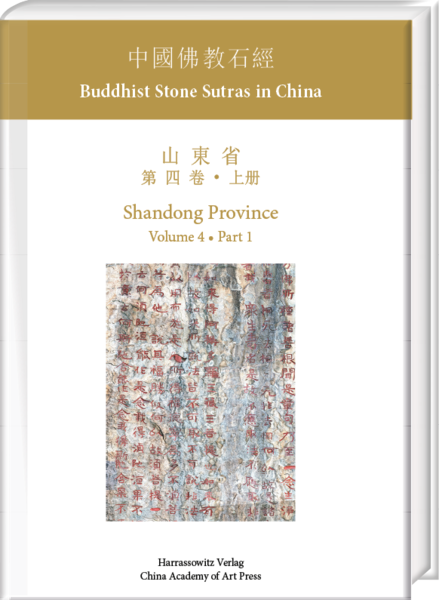中國佛教石經 - 山東省 - 第四卷: 泰山—經石峪
本卷分上下兩冊,是五卷本山東省佛教石經系列叢書中篇幅最大的一卷。此書聚焦於中國規模最宏偉的摩崖石刻——《金剛經》。此經位於泰山經石峪蔥鬱山水之間,在六世紀下半葉鐫刻於約兩千平方米的岩石斜坡之上。
《上冊:刻經》導論包括四篇文章。其一為雷德侯(Lothar Ledderose)《泰山經石峪概述》一文;其二為溫狄婭(Claudia Wenzel)《泰山〈金剛經〉》一文,探究了當地佛教發展歷史中的《金剛經》;其三為蔡穗玲《此經是塔》一文,探討了作為刻經址的經石峪原語境下的宗教禮儀功能;其四為王平國(Manuel Sassmann)《經石峪刻經研究史》一文,基於本卷《總錄》中翻譯的大量一手文本,作者追溯了十世紀以來直至今日有關刻經址的學術研究。《總錄》中亦涵蓋關於刻經址、刻經及其複製品的大量信息,並收錄照片、刻石拓片、矯正而成的完整原石面的正視圖像以及復原後的刻經原狀佈局。
《下冊:題跋》呈現了六十二則刻於經石峪的題跋,亦即附刻於刻經址周邊的歷史性銘文。這些刻銘始於一則與刻經同時、現已佚失的題跋,其中有一則1961年由最著名的馬克思主義知識份子郭沫若所題的刻銘,直至二十一世紀的碑銘。
下冊導論部分的首篇文章是精曉泰山歷史的當地重要學者周郢所作《經石峪明人鎸刻〈大學〉考》。他考證了一則刻於十六世紀,現已佚失的儒家經典《大學》刻銘。其後是雷德侯和蔡穗玲《經石峪之題跋》一文,綜理了幾個世紀以來的刻經址題跋。
其後的《總錄》部分詳盡記錄了全部題跋,並附有錄文及其翻譯,以及歷史與現代照片。題跋者生平資料以及對其文字的詮釋使讀者得以理解隨著時間推移,題跋者之於《金剛經》刻銘所持態度的發展變化。讀者還可以一觀這些題跋者在泰山的其他刻銘,由此獲得對作為中國最偉大景觀之一的《金剛經》刻銘的多元而又全面的觀賞。
《中國佛教石經》系列全書以繁體中文和英語雙語寫就,由中國美術學院出版社在亞洲地區出版發行,由Harrassowitz出版社在亞洲以外地區出版發行。
This volume—which is actually two, one for each part—is the largest of the five volumes in the Shandong series of Buddhist stone sutras, and it deals with the greatest of all the stone inscriptions in China: the Diamond Sutra, carved in the second half of the sixth century, on a slope of roughly 2000 square meters, in the lush landscape of Sutra Stone Valley on Mount Tai. The introduction to “Part 1: The Sutra” consists of four articles: “A Panoramic View” by Lothar Ledderose; “The Diamond Sutra on Mount Tai” by Claudia Wenzel, which embeds the sutra in the local history of Buddhism; “The Sutra as Stupa” by Tsai Suey-Ling, which investigates how the site originally functioned in religious practice; and “The Historiography of Sutra Stone Valley” by Manuel Sassmann, who traces scholarly engagement with the site from the tenth century till the present day, based on numerous sources that are translated in the catalog section. That section also contains extensive information about the site, the sutra and its reproductions, as well as photographs and rubbings of the characters on the rock, an orthophotographically rectified image of the entire stone surface, and the reconstructed layout of the text.
“Part 2: The Colophons” presents the 62 colophons—that is to say, inscriptions—which were added to the site, beginning with a lost colophon contemporary with the sutra, through an inscription of 1961 by the foremost Marxist intellectual Guo Moruo, down to those in the 21st century. The introduction begins with an article on “A Lost Inscription at Sutra Stone Valley” by Zhou Ying, the leading local expert on the history of Mount Tai, who analyses evidence for a lost sixteenth-century engraving of the Confucian classic the Great Learning. Following this is “The Colophons of Sutra Stone Valley” by Lothar Ledderose and Tsai Suey-Ling, who present an overview of the colophons at the site through the centuries. In the subsequent catalog section, all the colophons are documented in detail, transcribed and translated, and each is accompanied by photographs, both historical and contemporary. Biographical information on the makers of the inscriptions and interpretations of their texts allow the reader to understand how attitudes towards the Diamond Sutra developed and changed over the course of time. The reader is also taken on a tour of other inscriptions on the mountain by the colophon writers, and thus gains a multifaceted, holistic view of one of China’s greatest monuments.
The entire series 中國佛教石經 Buddhist Stone Sutras in China is in traditional Chinese and English throughout and is published by 中國美術學院出版社 (Distribution in Asian Countries) and Harrassowitz (Distribution in Non-Asian Countries).
《上冊:刻經》導論包括四篇文章。其一為雷德侯(Lothar Ledderose)《泰山經石峪概述》一文;其二為溫狄婭(Claudia Wenzel)《泰山〈金剛經〉》一文,探究了當地佛教發展歷史中的《金剛經》;其三為蔡穗玲《此經是塔》一文,探討了作為刻經址的經石峪原語境下的宗教禮儀功能;其四為王平國(Manuel Sassmann)《經石峪刻經研究史》一文,基於本卷《總錄》中翻譯的大量一手文本,作者追溯了十世紀以來直至今日有關刻經址的學術研究。《總錄》中亦涵蓋關於刻經址、刻經及其複製品的大量信息,並收錄照片、刻石拓片、矯正而成的完整原石面的正視圖像以及復原後的刻經原狀佈局。
《下冊:題跋》呈現了六十二則刻於經石峪的題跋,亦即附刻於刻經址周邊的歷史性銘文。這些刻銘始於一則與刻經同時、現已佚失的題跋,其中有一則1961年由最著名的馬克思主義知識份子郭沫若所題的刻銘,直至二十一世紀的碑銘。
下冊導論部分的首篇文章是精曉泰山歷史的當地重要學者周郢所作《經石峪明人鎸刻〈大學〉考》。他考證了一則刻於十六世紀,現已佚失的儒家經典《大學》刻銘。其後是雷德侯和蔡穗玲《經石峪之題跋》一文,綜理了幾個世紀以來的刻經址題跋。
其後的《總錄》部分詳盡記錄了全部題跋,並附有錄文及其翻譯,以及歷史與現代照片。題跋者生平資料以及對其文字的詮釋使讀者得以理解隨著時間推移,題跋者之於《金剛經》刻銘所持態度的發展變化。讀者還可以一觀這些題跋者在泰山的其他刻銘,由此獲得對作為中國最偉大景觀之一的《金剛經》刻銘的多元而又全面的觀賞。
《中國佛教石經》系列全書以繁體中文和英語雙語寫就,由中國美術學院出版社在亞洲地區出版發行,由Harrassowitz出版社在亞洲以外地區出版發行。
This volume—which is actually two, one for each part—is the largest of the five volumes in the Shandong series of Buddhist stone sutras, and it deals with the greatest of all the stone inscriptions in China: the Diamond Sutra, carved in the second half of the sixth century, on a slope of roughly 2000 square meters, in the lush landscape of Sutra Stone Valley on Mount Tai. The introduction to “Part 1: The Sutra” consists of four articles: “A Panoramic View” by Lothar Ledderose; “The Diamond Sutra on Mount Tai” by Claudia Wenzel, which embeds the sutra in the local history of Buddhism; “The Sutra as Stupa” by Tsai Suey-Ling, which investigates how the site originally functioned in religious practice; and “The Historiography of Sutra Stone Valley” by Manuel Sassmann, who traces scholarly engagement with the site from the tenth century till the present day, based on numerous sources that are translated in the catalog section. That section also contains extensive information about the site, the sutra and its reproductions, as well as photographs and rubbings of the characters on the rock, an orthophotographically rectified image of the entire stone surface, and the reconstructed layout of the text.
“Part 2: The Colophons” presents the 62 colophons—that is to say, inscriptions—which were added to the site, beginning with a lost colophon contemporary with the sutra, through an inscription of 1961 by the foremost Marxist intellectual Guo Moruo, down to those in the 21st century. The introduction begins with an article on “A Lost Inscription at Sutra Stone Valley” by Zhou Ying, the leading local expert on the history of Mount Tai, who analyses evidence for a lost sixteenth-century engraving of the Confucian classic the Great Learning. Following this is “The Colophons of Sutra Stone Valley” by Lothar Ledderose and Tsai Suey-Ling, who present an overview of the colophons at the site through the centuries. In the subsequent catalog section, all the colophons are documented in detail, transcribed and translated, and each is accompanied by photographs, both historical and contemporary. Biographical information on the makers of the inscriptions and interpretations of their texts allow the reader to understand how attitudes towards the Diamond Sutra developed and changed over the course of time. The reader is also taken on a tour of other inscriptions on the mountain by the colophon writers, and thus gains a multifaceted, holistic view of one of China’s greatest monuments.
The entire series 中國佛教石經 Buddhist Stone Sutras in China is in traditional Chinese and English throughout and is published by 中國美術學院出版社 (Distribution in Asian Countries) and Harrassowitz (Distribution in Non-Asian Countries).

出版商
中國美術學院出版社 / Harrassowitz
ISBN
978-7-5503-1046-9
出版年份
1 Jan 2022 – 30 Nov 2022
專業範疇
人文科學
主題
考古學
宗教
藝術與文化
歷史
地區
中國